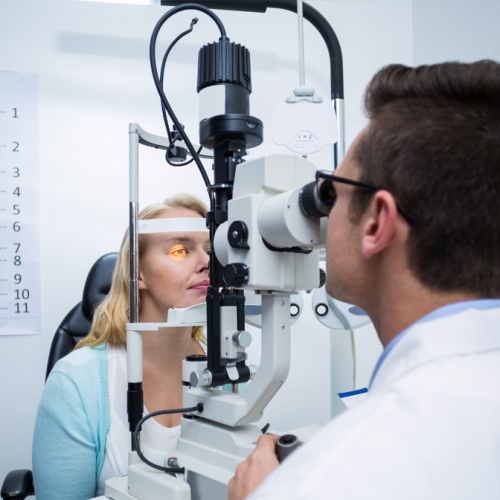
Common Visual Conditions
Everyone at some point in their lives will have or develop some type of vision impairment.
Laser Surgery Prices from just £66.67 per eye/month.
Based on 24 months Interest Free Finance and a £500 deposit
How your vision works
When looking at an object, the light reflecting from it enters the eye. This light enters the eye through the cornea which is the clear layer of tissue in front of the eye. The cornea bends the light and passes through the iris, which changes the size of the pupil depending on the brightness of the light. Once through the pupil, the light will enter the lens which focuses the light through the vitreous humour onto the retina wall. The retina’s surface comprises photoreceptors (light-sensitive neurons) that translate the light signal into an electric one and send the information along the optic nerve to the brain.
In a normal eye, the cornea and crystalline lens focus the light exactly on to a small area of the retina, producing a sharp image.
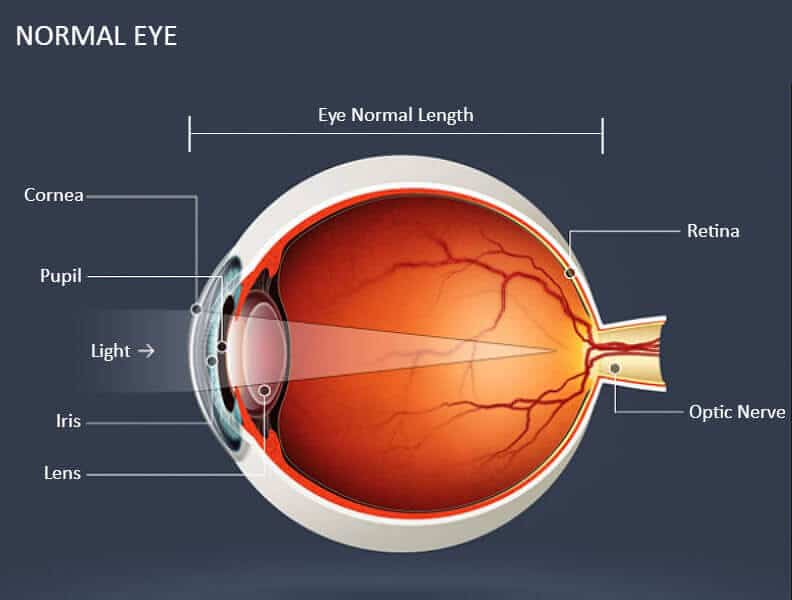
Precision Vision's innovative solutions
Precision Visoin has innovative solutions to the most common visual conditions. These include short/near-sightedness or myopia, long/far-sightedness or hyperopia, astigmatism and presbyopia, as well as blurred vision or loss of eyesight due to glaucoma, cataracts, or degenerative conditions.
We have the experts, knowledge, and technologies to perform total vision correction. Using the most advanced laser and non-laser technology, we can deliver a full range of techniques and procedures in a safe and painless manner. As pioneers in modern eye health, trust that our treatments will make a profound difference to your life.
For every common eyesight problem, we offer treatment options that are equally effective. These include:
State-of-the-Art Vision Care Focused on You
Your eyes are your gateway to the world. Having a visual impairment or being dependent on contact lenses or glasses prevents you from living life at its fullest. This is why we founded a practice that’s solely focused on eye sight and visual health care. Our mission is to make safe and painless corrective eye treatments within your reach.
Our treatments are performed to the highest clinical standards to deliver life-changing results. From common visual problems to complex eye conditions, our surgeons can deliver a treatment that’s right for you. We have the most advanced technologies and surgery theatres under one roof in a comfortable, relaxing clinic.
Consult with us and get a personalised vision correction treatment from Harley Street’s elite eye surgeons.
Most common visual conditions
This is when distant objects are blurred but close objects are clear.
This is caused by the eye being longer than normal or a steep cornea. When the light passes through the eye the steep cornea or the elongation of the eye causes the light to fall short of the retina and causes the light rays to cross each other producing a blurred image.
1 in 3 people in the UK have myopia
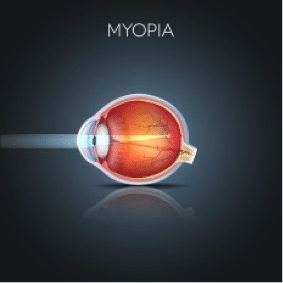
Treating Myopia:
Corrective lenses – Glasses with concave lenses and contact lenses.
Laser vision correction – The cornea is flattened to enable the light to reach the retina.
Implantable Contact Lenses – The lenses work like corrective lenses but are situated inside the eye.
Clear Lens Exchange – The crystalline lens of the eye is replaced with an artificial lens that alters the path of the light enabling it to reach the retina.
This is when close objects are blurry and distant objects are clear.
This can be caused by the cornea being flat, the lens not being thick enough or most commonly, the eye being shorter than normal. When the light passes through the eye the light trajectory goes beyond the retina producing a blurred image.
Approximately 13% of British people aged between 20 and 25 years have hyperopia
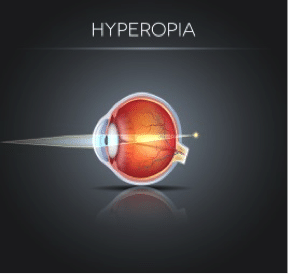
Treating Hyperopia:
Corrective lenses – Glasses with concave lenses and contact lenses.
Laser vision correction – The cornea is curved to enable the light to reach the retina.
Implantable Contact Lenses – The lenses work like corrective lenses but are situated inside the eye.
Clear Lens Exchange – The crystalline lens of the eye is replaced with an artificial lens that alters the path of the light enabling it to reach the retina.
This is when objects are blurry for both distance and near vision ranges.
This can be caused by the irregular shape of the cornea or lens. However it is most commonly due to the eye being more like a rugby ball shape rather than a football, consequently distorting the path of the light. This shape causes the light to scatter, leading to a blurry image and is often accompanied by myopia or hyperopia.
Approximately 9 out of 10 people have some degree of astigmatism
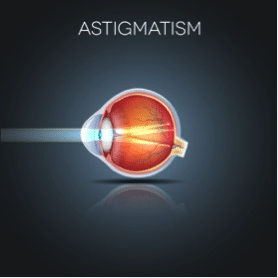
Treating Astigmatisms:
Corrective lenses – Glasses (irregularly shaped) and toric contact lenses.
Laser vision correction – The cornea is made more symmetrical enabling the light to reach the retina.
Implantable Contact Lenses – The lenses work like corrective contact lenses but are situated inside the eye.
Clear Lens Exchange – The natural lens of the eye is replaced with an artificial lens that alters the path of the light enabling it to reach the retina irrelevant of the presence of an astigmatism.
This is when close objects become blurry.
As the eye ages the crystalline lens stiffens and becomes less elastic. As the light passes through the eye, the lens is no longer able to adjust and focus the light on to the retina, causing it to focus beyond the retina producing a blurred image.
This will eventually occur to everyone over the age of 40, causing a need for reading glasses irrelevant of having used glasses or contact lenses in the past. Even people that have hyperopia (long sighted) will still experience the loss of near vision caused by presbyopia. It is represented in a prescription as a figure in the ADD section.
Treating Presbyopia:
Corrective lenses – Varifocals or two pairs of glasses/glasses and contact lenses (one to correct distance and the other for near vision)
Laser vision correction – Correct distance vision, leaving a reading prescription or Monovision laser correction (one eye corrected for distance and the other for reading).
Clear Lens Exchange – The crystalline lens of the eye is replaced with an artificial lens. Trifocal lenses allow for complete correction of a prescription simultaneously fixing distance, intermediate and near vision.
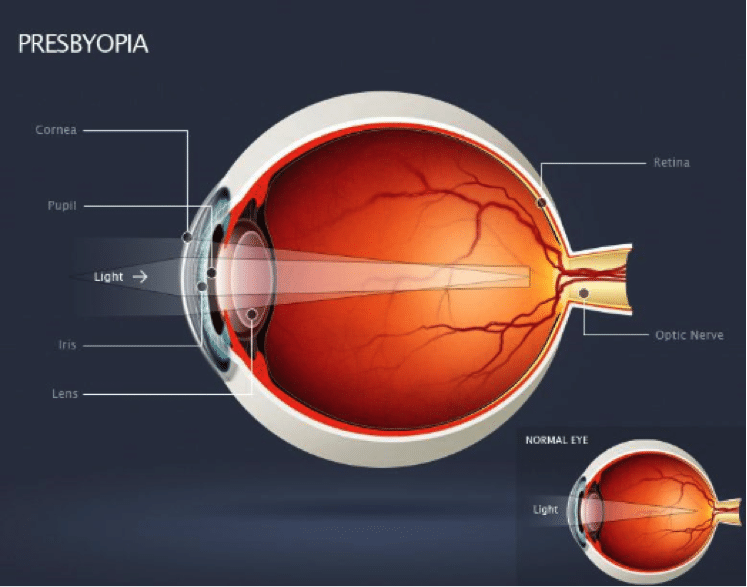
Understanding vision is what we do at Precision Vision.
Sight is extremely important and visual impairments of any degree can have drastic effects on your life. Glasses and contact lenses are a temporary solution often not allowing for use during most activities, consequently restricting lifestyles. Vision correction treatment is a permanent solution that can free you from your dependency on glasses and contact lenses
At Precisoin Vision we are devoted to patient care and outstanding results and have the country’s most advanced laser and non-laser surgical theatres. We are not just a laser clinic, we offer total vision correction. This enables us to treat patients of all ages with a variety treatments that correct a wide range of prescriptions.
Laser– For individuals over the age of 18 and there is no upper age limit. Treats short and long sight with or without astigmatisms. For those over the age of 40, a Monovision laser can treat both distant and near vision simultaneously.
Implantable Contact Lens– For individuals aged 40 years old or younger with high prescriptions, complex astigmatisms or are found unsuitable for laser surgery.
Cataracts and Clear Lens Exchange– For individuals over the age of 40 and have developed a cataract or a reading prescription. Trifocal lenses simultaneously treat all fields of vision (distance, near and intermediate).
How to read a prescription
When you have an eye exam you are often given a slip of paper containing your prescription. However most of us do not know how to read this information as we are unfamiliar with the terms and solely rely on what is told to us by our optometrist.
Not all eye prescriptions are the same and there is a significant difference between glasses and contact lenses prescriptions. This is due to the fact that glasses rest approximately 1 to 2 centimetres from your eyes and contact lenses are placed directly on the surface of the eye, and also because contact lenses prescriptions contain information directly related to size and positioning of the lens.
Overall, glasses prescriptions are a more accurate account of an individual’s visual conditions, given that glasses are able to accommodate for the correction of more complex conditions than contact lenses.
Example of a glasses prescription:
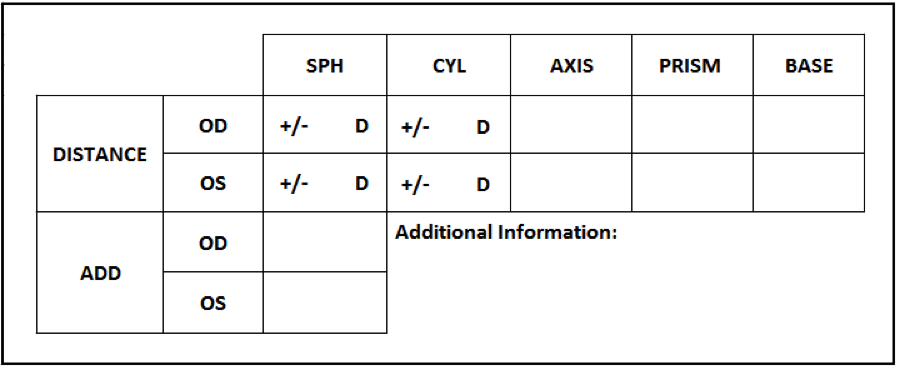
There are a lot of abbreviations used for medical terms and without knowing what these mean it is very difficult to read a prescription. Below is a list of the most commonly used terms and abbreviations:
Your 4 step Treatment Plan
Our approach revolves around prioritising your optimal well-being.
Prior to your consultation
Your first point of contact will be with Precision Vision’s highly trained and knowledgeable patient coordinators.
Treatment
Unlike other eye clinics, Precision Vision has both our laser and non-laser theatres under one roof, enabling you to be treated in one convenient location.
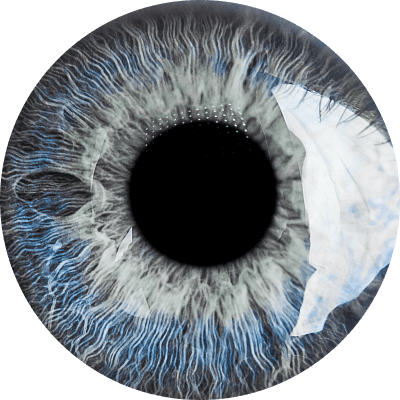
Consultation
At Precision Vision, we believe that it is essential to be selective to ensure that every patient has the best treatment to suit their visual and lifestyle needs which is why determining suitability is incredibly important.
Aftercare
Your aftercare begins immediately after treatment when you are taken to the recovery room to relax and, when you are ready to leave, our specialist nurse will examine you before you go home.
Why choose Precision Vision for Common Visual Conditions
Gold standard in laser treatment, using only the safest and most advanced technology to provide outstanding results, constantly surpassing expectations. Precision Vision has the fastest treating excimer laser available on the market, treatment typically taking only 3 to 5 seconds. Precision Vision is the first and only clinic in Europe to have a transparent theatre, used for purposes of training and allowing families to watch treatment. Both laser vision correcting treatments (Lasik and Lasek) are approved by the FDA.
Truly bespoke treatment plans individually designed for each eye of every patient. Dr Pillai was one of the first surgeons in the UK to perform bilateral (both eyes treated on the same day) Lasik treatment. Precision Vision’s Medical Director and laser surgeon is a refractive and corneal specialist with over 30 years of experience as an ophthalmic surgeon.
If a patient is found unsuitable for laser treatment, alternative treatments can be offered to correct the prescription. Precision Vision has the largest independent optometrist network in the country, meaning patients can have treatment at the Harley Street clinic and enjoy incredible aftercare at a more convenient location. Transparent pricing – you pay the same price regardless of how complex your prescription is.


